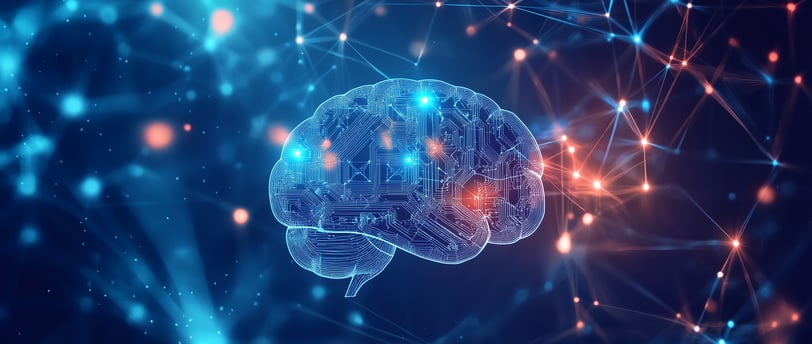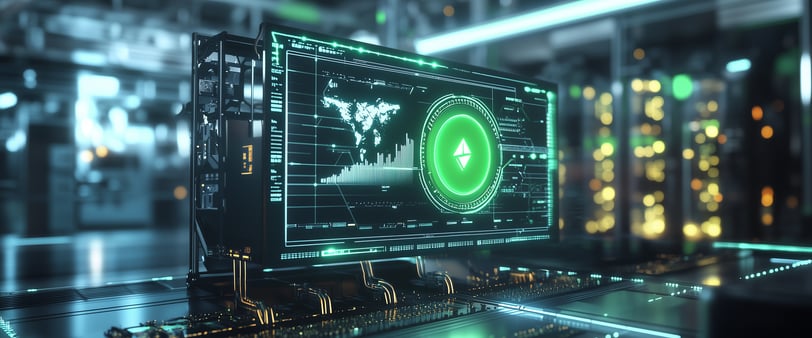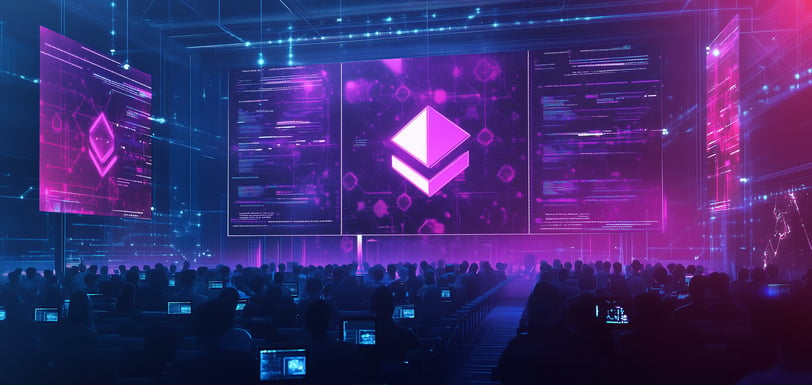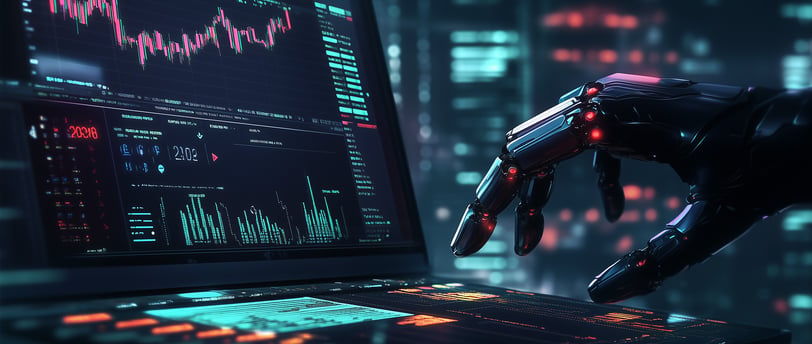The Rise of AI in Blockchain: How Artificial Intelligence Is Transforming Crypto
Discover how artificial intelligence is transforming blockchain technology. Learn how AI enhances security, automates transactions, and analyzes crypto markets while reshaping industries.
VaultKeyPress
1/25/20255 min read


3. Market Analysis and Trading Strategies
The crypto market is notorious for its volatility, making it a fertile ground for AI-powered trading and analysis tools. AI excels in processing real-time data and historical trends, enabling traders to make more informed decisions.
AI-Powered Trading Bots
Trading bots with AI algorithms can execute trades faster and more efficiently than human traders. These bots use techniques like:
Sentiment Analysis: Scanning social media and news sources to gauge market sentiment and predict price movements.
Pattern Recognition: Identifying technical chart patterns and using historical data to predict future price trends.
Example: CryptoHopper
CryptoHopper is an AI-driven trading bot that uses machine learning to analyze market data and execute trades automatically, maximizing profits in highly volatile markets.
Predicting Long-Term Trends
AI can analyze macroeconomic indicators, on-chain data, and global financial trends to provide insights into long-term crypto market behavior. For instance, it can forecast how Bitcoin halving events might influence future prices.
4. Enhancing Scalability with AI
Scalability remains a challenge for many blockchain networks, particularly as transaction volumes increase. AI offers innovative solutions to optimize performance and reduce bottlenecks.
AI for Network Optimization
AI can predict traffic patterns on a blockchain network and optimize resource allocation to prevent congestion. For example:
Dynamic Sharding: AI can determine the most efficient way to split blockchain data into smaller segments, reducing transaction processing times.
Load Balancing: AI algorithms can distribute transaction loads more evenly across nodes, ensuring consistent performance.
Example: Fetch.ai
Fetch.ai is a blockchain platform that uses AI to enable autonomous economic agents to perform tasks such as data sharing and resource optimization, improving scalability and efficiency.
5. Improving Blockchain Interoperability
As the blockchain ecosystem grows, interoperability - allowing different blockchains to communicate and interact - is becoming increasingly important. AI can facilitate seamless connections between disparate networks.
AI for Cross-Chain Communication
AI algorithms can identify optimal pathways for transferring assets or data across blockchains. This reduces the complexity of bridging networks and ensures faster and more secure transactions.
Example: Polkadot and AI
While Polkadot focuses on interoperability, integrating AI tools could enhance its ability to automate cross-chain transactions and streamline communication between parachains.
6. Addressing Energy Consumption
Blockchain networks, particularly Proof-of-Work (PoW) systems like Bitcoin, have faced criticism for their energy consumption. AI is being deployed to tackle this issue by optimizing mining processes and encouraging sustainable practices.
AI for Energy Efficiency
Mining Optimization: AI algorithms can analyze mining hardware performance and suggest configurations to maximize output while minimizing energy use.
Renewable Integration: AI can predict renewable energy availability (e.g., solar or wind) and align mining operations with peak supply periods.
Example: Nvidia’s AI GPUs
Nvidia’s GPUs, widely used for mining, are now leveraging AI to improve energy efficiency and performance, reducing the carbon footprint of mining operations.
7. AI-Driven Governance in Blockchain
Decentralized Autonomous Organizations (DAOs) rely on community governance for decision-making. Integrating AI into DAOs can streamline governance processes by providing data-driven insights and automating routine tasks.
AI in Voting and Proposals
Enhanced Decision-Making: AI can analyze historical voting patterns and predict the potential impact of proposed changes.
Streamlining Operations: AI can automate proposal evaluation, ensuring only viable ideas reach the community vote.
Example: SingularityNET
SingularityNET is a blockchain-based platform that integrates AI to enable decentralized governance, allowing communities to make smarter, more informed decisions.
Challenges and Ethical Considerations
While the integration of AI and blockchain offers immense potential, it’s not without challenges:
Bias in AI Algorithms: AI systems are only as good as the data they’re trained on. Biased or incomplete datasets can lead to flawed decisions.
Data Privacy: Combining AI with blockchain raises questions about how sensitive data is used and stored.
Energy Consumption: While AI can optimize energy use, its training models require significant computational power, adding to the overall environmental impact.
Autonomy vs. Control: Balancing the decentralized ethos of blockchain with the centralized nature of many AI models can create tensions.
The Future of AI and Blockchain Integration
The fusion of AI and blockchain is still in its early stages, but the potential is enormous. From securing networks and automating transactions to enhancing scalability and governance, AI is helping blockchain systems reach new levels of efficiency and innovation.
As these technologies continue to evolve, their integration could redefine industries, unlock new economic models, and challenge traditional systems of power and control. However, ensuring ethical and transparent use of these tools will be critical to realizing their full potential.
Final Thoughts
The integration of AI and blockchain represents a convergence of two revolutionary technologies, each enhancing the other’s strengths. While challenges remain, the synergy between AI and blockchain is already driving innovation in security, automation, and scalability. As the crypto space evolves, staying informed about these advancements will be key to navigating the future of finance and technology.
Curious to Learn More?
For more insights into blockchain, AI, and the future of crypto, subscribe to our mailing list and stay updated on the release of Crypto Unlocked: The Modern Guide to Digital Wealth.
This guide covers everything from understanding blockchain fundamentals to long-term investment strategies tailored for the modern age.
👉 Sign up here for exclusive updates and to secure your copy of Crypto Unlocked before its release!
Blockchain and artificial intelligence (AI) are two of the most transformative technologies of the 21st century so far. While blockchain revolutionizes how we think about trust, transparency, and decentralization, AI analyzes vast amounts of data, identifies patterns, and makes intelligent decisions. The convergence of these two technologies creates new possibilities that could reshape industries ranging from finance and healthcare to supply chains and gaming.
In this article, we’ll explore how AI tools are integrated into blockchain technology, enhancing security, automating transactions, and analyzing market trends. By understanding these advancements, you can gain insight into the future of crypto and its evolving relationship with AI.
1. Optimizing Blockchain Security with AI
Security is one of the most critical aspects of blockchain and cryptocurrency. While blockchains are inherently secure due to their decentralized nature, vulnerabilities often emerge at the user and application levels. AI is playing a pivotal role in addressing these challenges.
AI-Powered Fraud Detection
AI can analyze large datasets in real time, identifying unusual patterns or anomalies that could indicate fraudulent activity. For example:
Monitoring Transactions: AI algorithms can scan blockchain transactions to detect suspicious activity, such as abnormal transaction sizes or repeated attempts to access a wallet.
Preventing Hacks: AI can alert developers to potential exploits before they are targeted by identifying vulnerabilities in smart contracts or applications.
Example: Sentinel Protocol
Platforms like Sentinel Protocol use AI-driven threat intelligence to identify and block malicious actors in the blockchain space. This includes phishing attempts, scam addresses, and ransomware threats.
2. Automating Transactions with Smart Contracts and AI
Smart contracts have already revolutionized the way agreements are executed by removing the need for intermediaries. Smart contracts can become even more powerful and adaptive when combined with AI.
Dynamic Smart Contracts
AI can make smart contracts smarter by enabling them to adapt to external conditions or inputs. For example:
Supply Chain Automation: In logistics, an AI-enabled smart contract could adjust payment terms dynamically based on real-time shipping data, such as delays or temperature changes for perishable goods.
Insurance Claims: AI can analyze data from IoT devices to verify claims and trigger smart contract payouts automatically.
Example: IBM and Maersk
IBM’s blockchain platform for supply chains integrates AI to monitor shipments, predict delays, and automate payments through smart contracts.








Unlock your financial future with our insights.
© 2024 VaultKey Press. All Rights Reserved.




